New Equation for Predicting Pipe Friction Coefficients Using the Statistical Based Entropy Concepts
Abstract
:1. Introduction
2. Methodology
2.1. Chiu’s Velocity and Darcy–Weisbach Equation
2.2. Estimation of the Friction Head Loss
3. Application
3.1. Smooth Pipe
3.2. Rough Pipe
3.3. RMSE (Root Mean Square Error)
4. Results and Discussion
5. Conclusions
Author Contributions
Funding
Acknowledgments
Conflicts of Interest
References
- Jones, O.C. An improvement in the calculation of turbulent friction in rectangular ducts. J. Fluids Eng. 1976, 98, 173–180. [Google Scholar] [CrossRef]
- Garcia, E.J.; Steffe, J.F. Comparison of friction factor equations for non-newtonian fluids in pipe flow. J. Food Process. Eng. 1986, 9, 93–120. [Google Scholar] [CrossRef]
- Su, Z.; Gudmundsson, J.S. Friction factor of perforation roughness in pipes. In SPE Annual Technical Conference and Exhibition; Society of Petroleum Engineers: Houston, TX, USA, 1994. [Google Scholar] [CrossRef]
- Romeo, E.; Royo, C.; Monzón, A. Improved explicit equations for estimation of the friction factor in rough and smooth pipes. Chem. Eng. J. 2002, 86, 369–374. [Google Scholar] [CrossRef]
- McKeon, B.J.; Swanson, C.J.; Zagarola, M.V.; Donnelly, R.J.; Smits, A.J. Friction factors for smooth pipe flow. J. Fluid Mech. 2004, 511, 41–44. [Google Scholar] [CrossRef] [Green Version]
- Cheng, N.S. Formulas for friction factor in transitional regimes. J. Hydraul. Eng. 2008, 134, 1357–1362. [Google Scholar] [CrossRef]
- Trinh, K.T. On the Blasius correlation for friction factors. arXiv 2010, arXiv:1007.2466. [Google Scholar]
- Calomino, F.; Alfonsi, G.; Gaudio, R.; Ippolito, A.D.; Lauria, A.; Tafarojnoruz, A.; Artese, S. Experimental and numerical study of free-surface flows in a corrugated pipe. Water 2018, 10, 638. [Google Scholar] [CrossRef] [Green Version]
- Tonye, K.J. A computer program for pipe friction factor calculation. Int. J. Eng. Technol. 2012, 2, 266–269. [Google Scholar]
- Padilla, E.A.; Begovich, O.; Pizano-Moreno, A. Friction Coefficient in plastic pipelines. In Fluid Dynamics in Physics, Engineering and Environmental Application; Springer: Berlin/Heidelberg, Germany, 2013; pp. 449–454. [Google Scholar] [CrossRef]
- Neihguk, D.; Munjal, M.L.; Prasad, A. Friction factor for perforated pipes. In Proceedings of the COMSOL Conference 2015, Pune, India, 17 November 2015. [Google Scholar]
- Liakopoulos, A.; Sofos, F.; Karakasidis, T.E. Friction factor in nanochannel flows. Microfluid. Nanofluidics 2016, 20, 24. [Google Scholar] [CrossRef]
- Ramos, F.; Cruz, D.; Anbarlooei, H. New friction factor and mean velocity profile for turbulent pipe flow at extreme Reynolds number. Bull. Am. Phys. Soc. 2018, 63, 13. [Google Scholar]
- Najafzadeh, M.; Shiri, J.; Sadeghi, G.; Ghaei, A. Prediction of the friction factor in pipes using model tree. ISH J. Hydraul. Eng. 2018, 24, 9–15. [Google Scholar] [CrossRef]
- Mishra, M.; Deshpande, A.; Kumar, B. Performance appraisal of friction factor estimators. In Hydrologic Modeling; Springer: Berlin/Heidelberg, Germany, 2018; pp. 475–498. [Google Scholar] [CrossRef]
- Díaz-Damacillo, L.; Plascencia, G. A new six parameter model to estimate the friction factor. AIChE J. 2019, 65, 1144–1148. [Google Scholar] [CrossRef]
- Pérez-Pupo, J.R.; Navarro-Ojeda, M.N.; Pérez-Guerrero, J.N.; Batista-Zaldívar, M.A. On the explicit expressions for the determination of the friction factor in turbulent regime. Rev. Mex. Ing. Química 2020, 19, 313–334. [Google Scholar] [CrossRef] [Green Version]
- Chiu, C.L. Velocity distribution in open channel flow. J. Hydraul. Eng. 1988, 115, 576–594. [Google Scholar] [CrossRef]
- Chiu, C.L. Application of entropy concept in open-channel flow study. J. Hydraul. Eng. 1989, 117, 615–628. [Google Scholar] [CrossRef]
- Nikuradse, J. Laws of Flow in Rough Pipes. Translation of Stromungsgesetze in Rauhen Rohren. Nikuradse, Forschung auf dem Gebiete des Ingenieurwesens; NACA Technical Memorandum 1292; NACA: Washington, DC, USA, 1933. [Google Scholar]
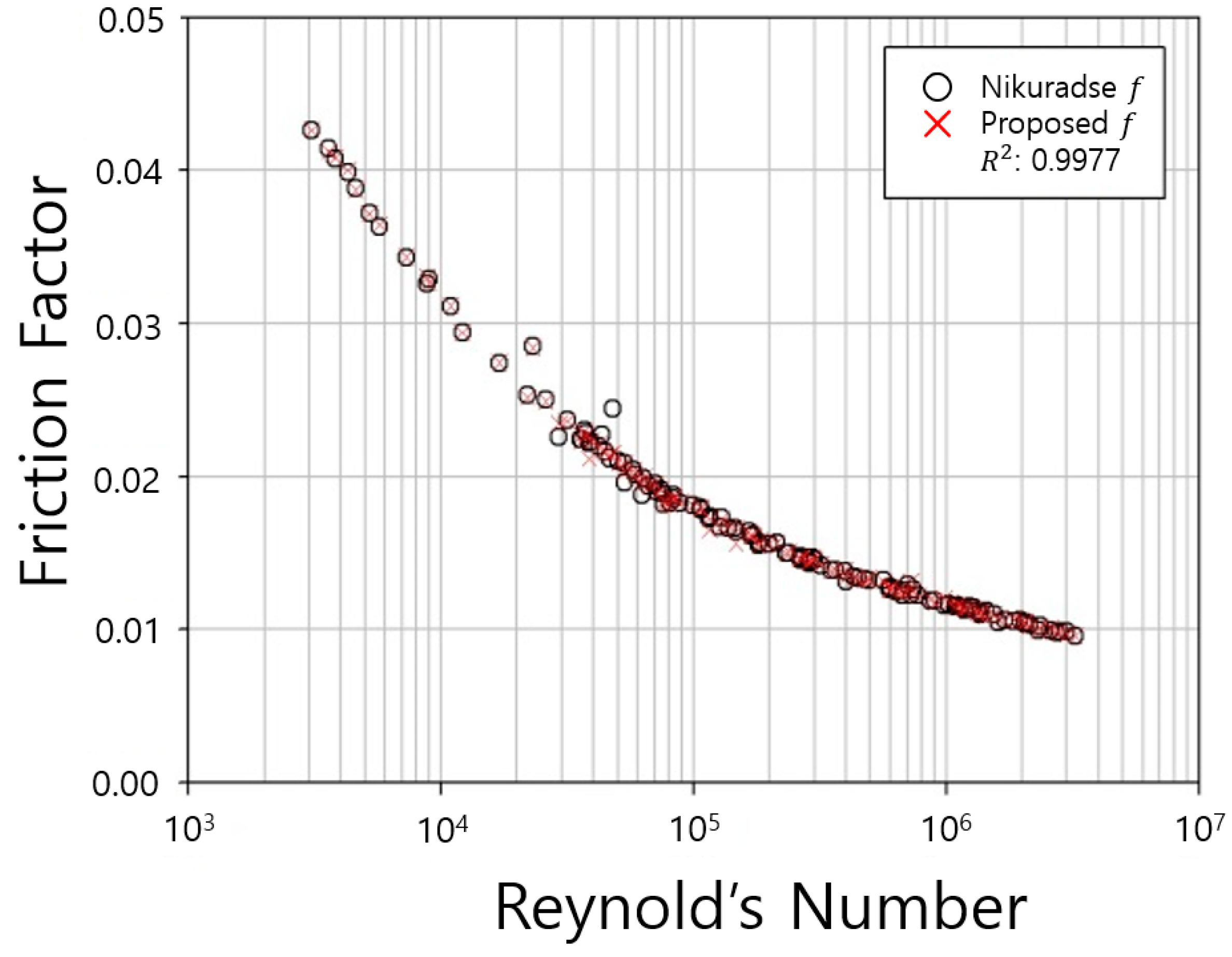
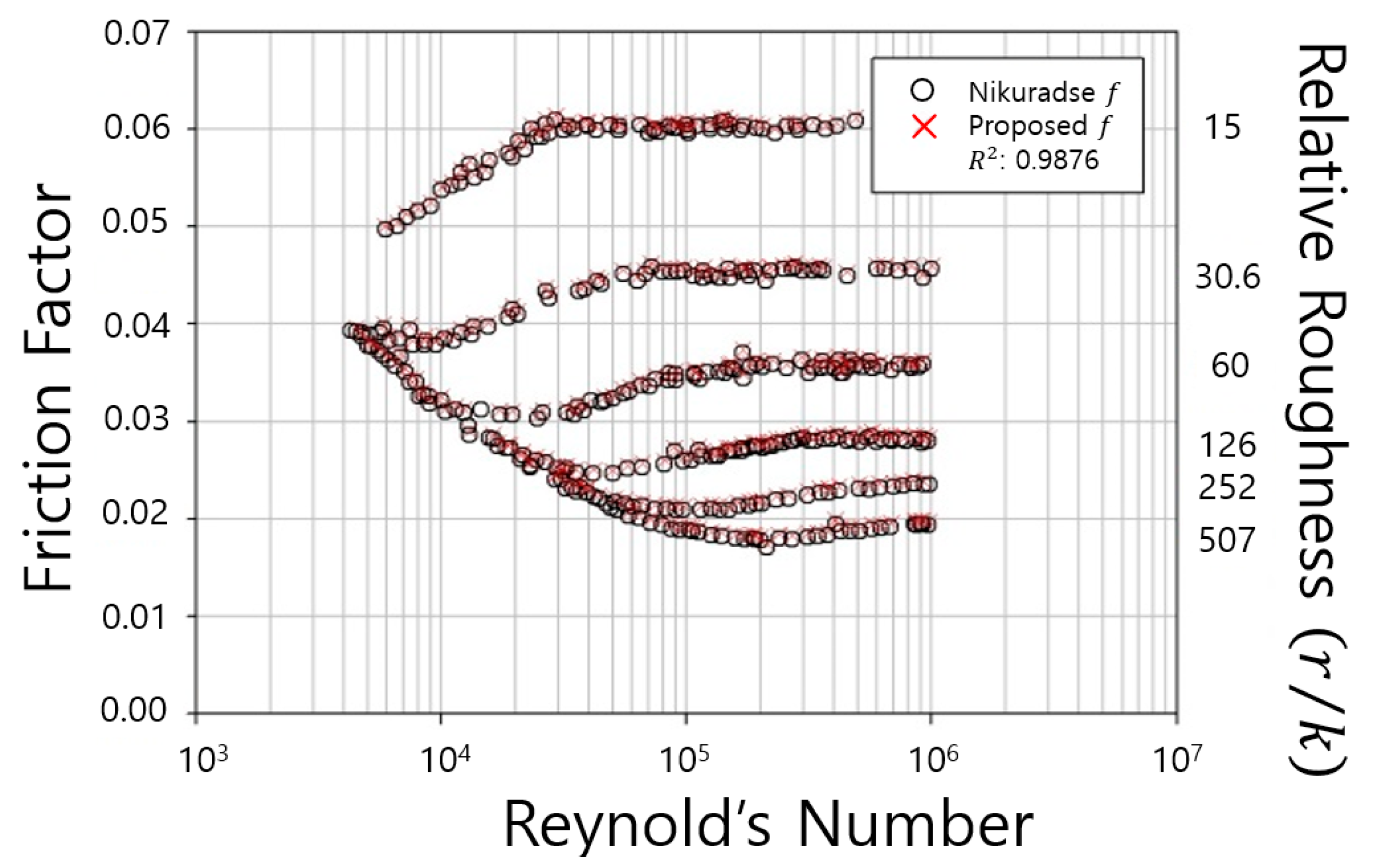



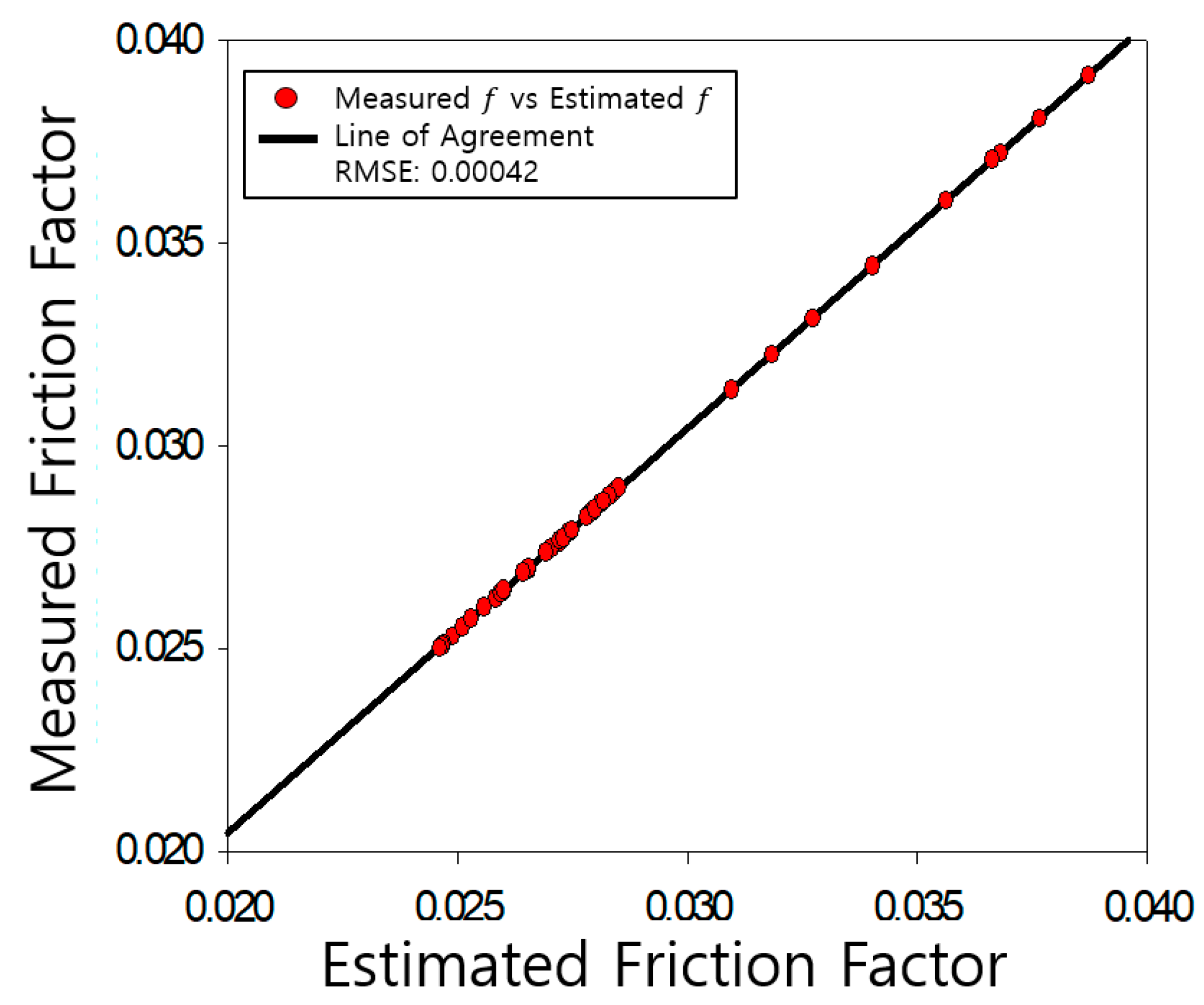

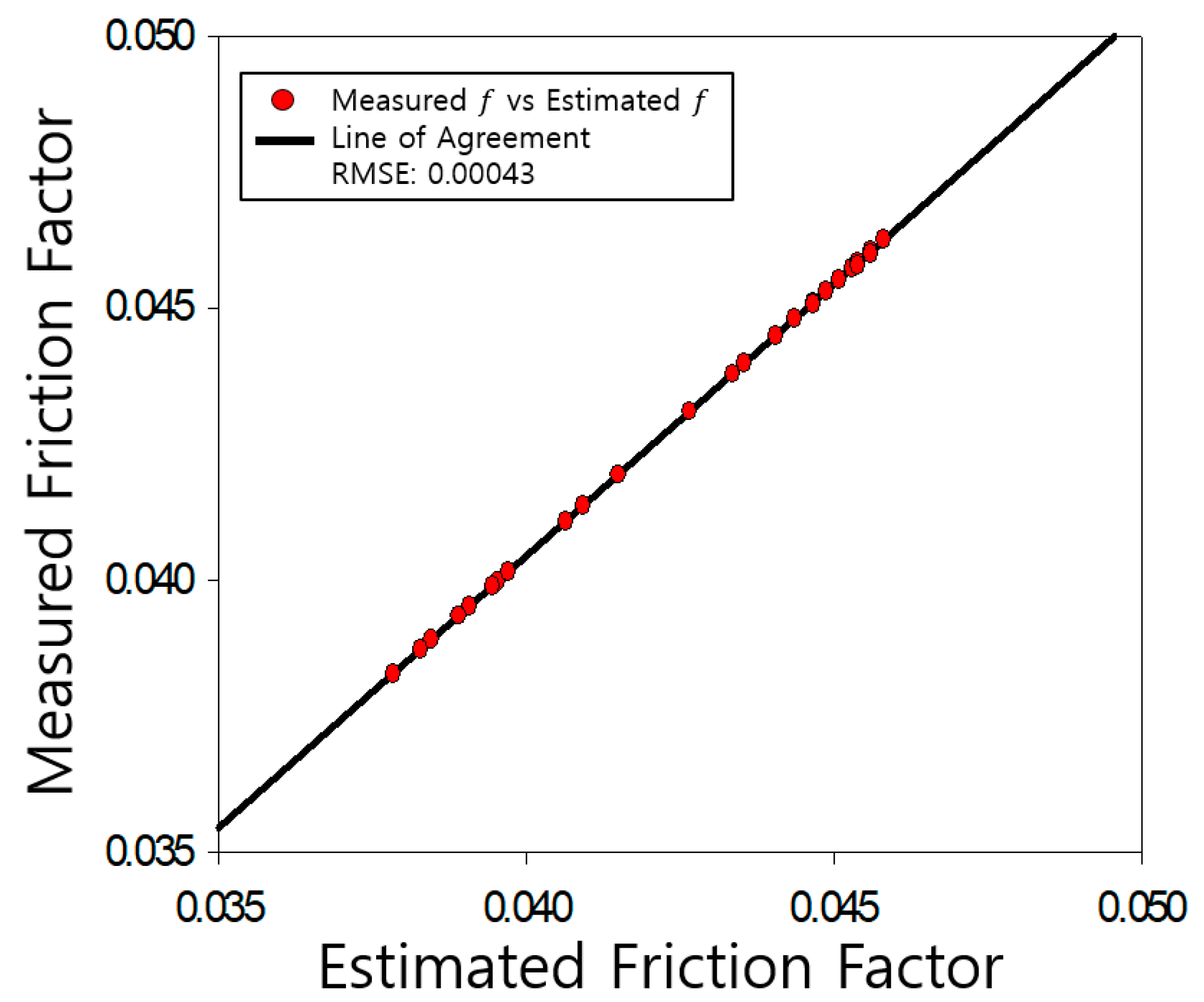
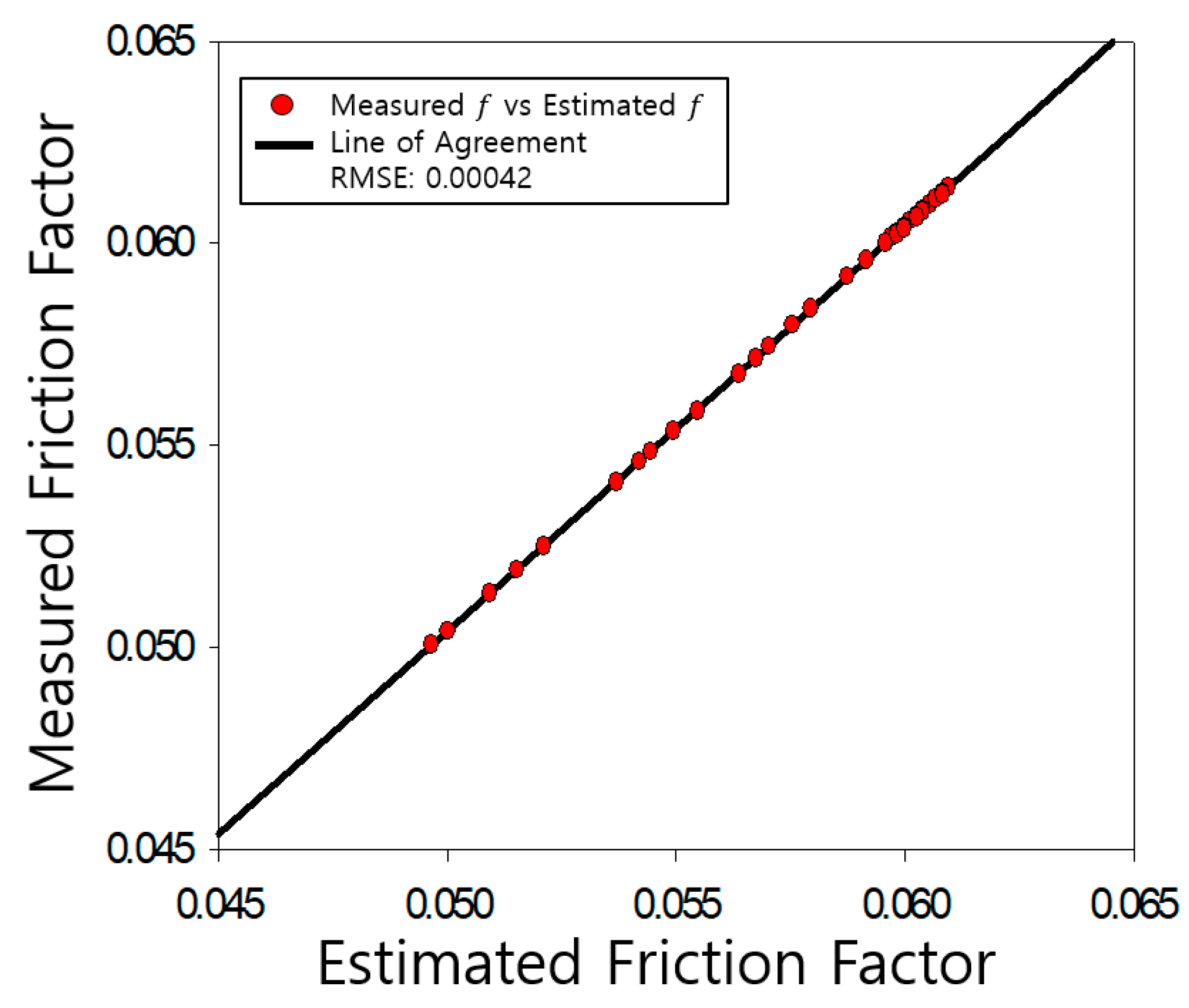

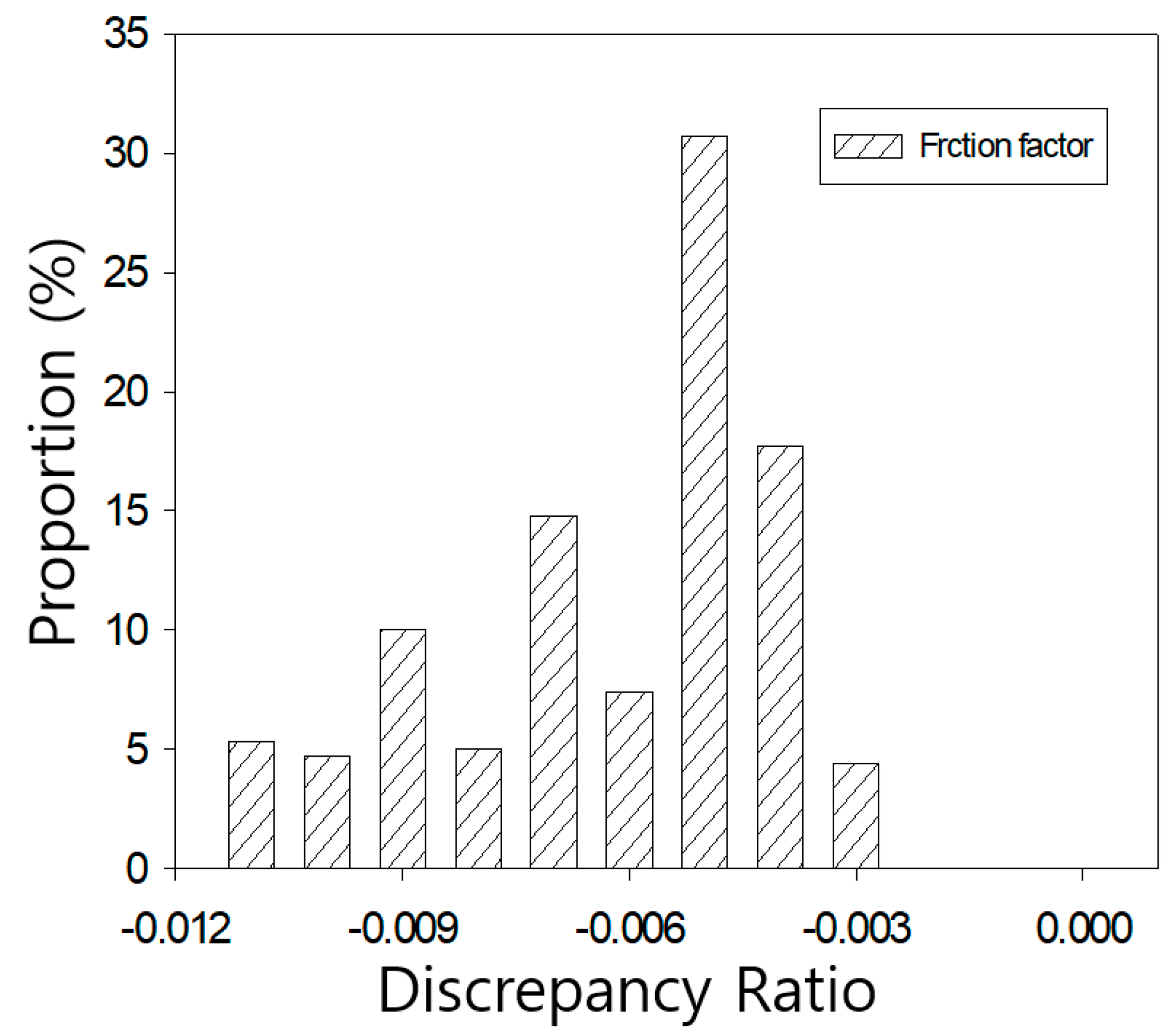
| D | F(M) | ||||||
|---|---|---|---|---|---|---|---|
| 1 | 0.25 | 3.124 ~14.206 | 42.8 ~311 | 0.014 ~0.0135 | 4.072 ~12.428 | 3.07 ~23 | 0.016692 ~0.042626 |
| 2 | 0.5 | 6.711 ~46.792 | 114.6 ~1053 | 0.0114 ~0.0135 | 14.555 ~89.625 | 17 ~182 | 0.015797 ~0.027434 |
| 3 | 0.75 | 4.895 ~46.996 | 91.4 ~1106 | 0.0114 ~0.0123 | 15.948 ~130.237 | 37 ~288 | 0.01444 ~0.02295 |
| 5 | 1.25 | 3.857 ~42.657 | 71.2 ~1082 | 0.0134 ~0.0081 | 21.517 ~259.529 | 29.3 ~670 | 0.0124344 ~0.0234805 |
| 10 | 2.5 | 11.234 ~83.999 | 259 ~2425 | 0.0122 ~0.007 | 112.076 ~969.883 | 238.8 ~3230 | 0.0095988 ~0.0150519 |
| r/k | D | F(M) | ||||||
|---|---|---|---|---|---|---|---|---|
| 507 | 9.94 | 2.485 | 0.923 ~41.621 | 15.45 ~845 | 0.009 ~0.012 | 11.622 ~586.711 | 13.0017 ~970.51 | 0.0171 ~0.0286 |
| 252 | 9.94 | 2.485 | 3.753 ~47.724 | 72.3 ~880 | 0.0089 ~0.0128 | 37.815 ~722.652 | 55.9758 ~979.49 | 0.0209 ~0.0236 |
| 4.94 | 1.235 | 2.578 ~59.494 | 43.4 ~1104 | 0.0086 ~0.0132 | 14.325 ~44.893 | 16.2181 ~612.35 | 0.0209 ~0.0282 | |
| 126 | 9.94 | 2.485 | 7.018 ~49.213 | 121 ~832 | 0.0081 ~0.0135 | 85.427 ~820.413 | 88.1251 ~970.51 | 0.026 ~0.0285 |
| 2.474 | 0.6185 | 1.597 ~43.793 | 22.8 ~755 | 0.128 ~0.133 | 0.524 ~12.274 | 2.4917 ~145.881 | 0.0246 ~0.0393 | |
| 60 | 9.8 | 2.434 | 6.611 ~60.015 | 101 ~896 | 0.0092 ~0.0132 | 80.32 ~1027.512 | 74.9894 ~916.22 | 0.0342 ~0.037 |
| 2.434 | 0.6085 | 1.665 ~52.158 | 23.8 ~795 | 0.0114 ~0.0128 | 5.54 ~182.656 | 4.4978 ~170.216 | 0.0303 ~0.0392 | |
| 30.6 | 9.64 | 2.41 | 7.449 ~70.518 | 99 ~934 | 0.009 ~0.011 | 121.686 ~1425.711 | 85.9014 ~1000 | 0.0447 ~0.0458 |
| 4.87 | 1.2175 | 5.153 ~73.023 | 70 ~975 | 0.0105 ~0.0128 | 36.08 ~634.153 | 26.6073 ~451.856 | 0.0426 ~0.0458 | |
| 2.434 | 0.6085 | 1.704 ~49.616 | 24.9 ~664 | 0.0107 ~0.0129 | 5.738 ~210.841 | 4.69894 ~151.008 | 0.0378 ~0.0453 | |
| 15 | 4.82 | 1.205 | 6.515 ~142.177 | 75.5 ~1648 | 0.0072 ~0.0132 | 51.318 ~1957.896 | 27.5423 ~1018.59 | 0.0596 ~0.0608 |
| 2.412 | 0.603 | 2.427 ~68.31 | 30.81 ~788 | 0.0098 ~0.0126 | 9.153 ~364.357 | 5.88844 ~192.752 | 0.0497 ~0.061 |
| Smooth | R2 | RMSE | |
| 0.9977 | 0.000366 | ||
| rough | 507 | 0.9923 | 0.000436 |
| 252 | 0.9796 | 0.000434 | |
| 126 | 0.9886 | 0.000423 | |
| 60 | 0.9875 | 0.000399 | |
| 30.6 | 0.9941 | 0.000433 | |
| 15 | 0.9846 | 0.000420 | |
Publisher’s Note: MDPI stays neutral with regard to jurisdictional claims in published maps and institutional affiliations. |
© 2021 by the authors. Licensee MDPI, Basel, Switzerland. This article is an open access article distributed under the terms and conditions of the Creative Commons Attribution (CC BY) license (https://creativecommons.org/licenses/by/4.0/).
Share and Cite
Choe, Y.-W.; Sim, S.-B.; Choo, Y.-M. New Equation for Predicting Pipe Friction Coefficients Using the Statistical Based Entropy Concepts. Entropy 2021, 23, 611. https://0-doi-org.brum.beds.ac.uk/10.3390/e23050611
Choe Y-W, Sim S-B, Choo Y-M. New Equation for Predicting Pipe Friction Coefficients Using the Statistical Based Entropy Concepts. Entropy. 2021; 23(5):611. https://0-doi-org.brum.beds.ac.uk/10.3390/e23050611
Chicago/Turabian StyleChoe, Yeon-Woong, Sang-Bo Sim, and Yeon-Moon Choo. 2021. "New Equation for Predicting Pipe Friction Coefficients Using the Statistical Based Entropy Concepts" Entropy 23, no. 5: 611. https://0-doi-org.brum.beds.ac.uk/10.3390/e23050611







